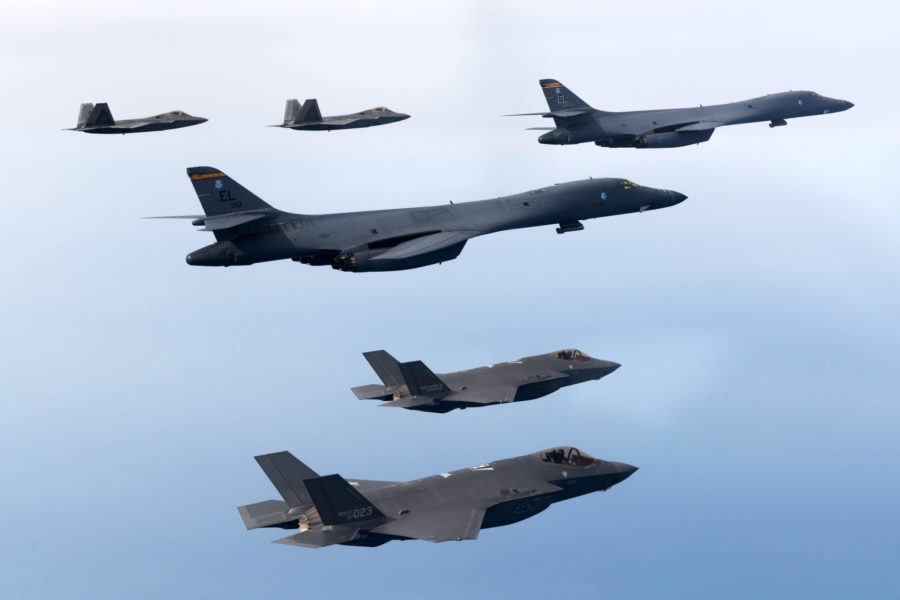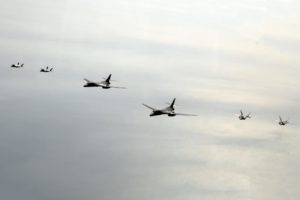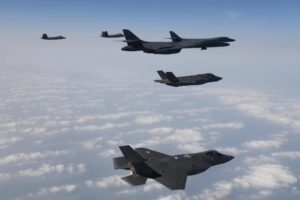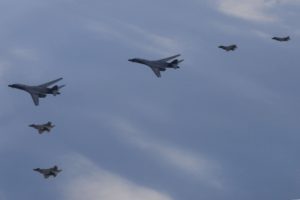A pair of U.S. Air Force B-1B Lancers and F-22 Raptors flew alongside F-35s from the Republic of Korea on Feb. 1—the third bomber flight near the Korean Peninsula in recent months. The jets then trained Feb. 3 with USAF F-22s, Marine Corps F-35Bs, and ROK F-35s.
The B-1s subsequently flew to Andersen Air Force Base, Guam, to kick off another Bomber Task Force deployment.
The Republic of Korea Defense Ministry announced the first round of joint air training Feb. 2, saying the aircraft linked up over the Yellow Sea, just west of the Peninsula. The ROK Air Force announced the second round Feb. 3, according to multiple media reports, noting that it also took place over the Yellow Sea.
A Pacific Air Forces spokesman confirmed to Air & Space Forces Magazine that the B-1s came from Ellsworth Air Force Base, S.D., and the F-22s came from Joint Base Elmendorf–Richardson. A release from PACAF announced the Bomber Task Force mission.
The combined flight marks the first combined air training between the ROK, or South Korean, Air Force and the U.S. Air Force in 2023, though U.S. bombers have become a frequent sight in the skies near South Korea recently.
In late December, B-52 Stratofortresses from Barksdale Air Force Base, La., flew alongside American F-22s and ROK F-35s and F-15s around Jeju Island south of the peninsula. And in November, B-1s from Ellsworth flew over the Peninsula for the first time in five years.
In both cases, the bombers’ flights represented shows of force shortly after North Korea conducted missile tests.
These most recent flights came just a days after Defense Secretary Lloyd J. Austin III visited Seoul and pledged alongside South Korean defense minister Lee Jong-sup to increase the size and scope of joint U.S.-ROK military exercises. That includes increased participation from fifth-gen fighters and strategic bombers.
Ellsworth B-1s last participated in an Indo-Pacific BTF in the fall, from October to November.
“It’s a privilege to be back in the Pacific area of responsibility and to be on the forward-edge of deterring our adversaries and supporting our Allies,” Maj. Abraham Moreland, assistant director of operations for the 34th Expeditionary Bomb Squadron, said in a statement. “The relationships we have with our Allies in the region are crucial to the security of the Indo-Pacific, and the partnerships we build while out here give our aircrews the critical training and experience necessary to be successful in this environment.”
The U.S. missions both reassure South Korea and respond to mounting pressure from North Korea, where Kim Jong Un has stepped up missile tests and recently launched drones over South Korean airspace.
With tensions increasing, South Korean president Yoon Suk Yeol made waves by saying his country may be forced to either ask the U.S. to redeploy nuclear arms on the peninsula or to develop nuclear weapons of its own. And a recent independent, bipartisan commission recommended the two countries begin “pre-decisional” discussions about what it would take to redeploy tactical nuclear weapons to the region.



